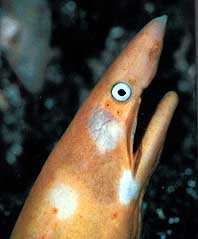To the Japanese who awake each day in the cool shadows of
Mount Fuji, the volcanic cone and the brooding Suruga Bay at its foot both
form a magical partnership. The upper slopes of the mountain house the bright
and lofty gods which serve and protect. Suruga Bay, its waters cloaked in
deepest black, is dark and forbidding; the realm of demons.
 Sixteen
different kinds of dragonet fish are found in Suruga Bay
Sixteen
different kinds of dragonet fish are found in Suruga Bay
Suruga Bay is about 40 miles long and, in some places, 35
miles wide. It is bordered on the north by Mount Fuji, and on the east by the
mountainous Izu Peninsula. What makes it so special is its extraordinary depth
- plunging to more than 8,000 feet a few miles offshore - and the deep sea
creatures that live there. The deep ocean seems to send arteries reaching
toward Japan, pumping life into the shallow waters along her shores. The deep
troughs of Suruga Bay and the Sagami Sea on the eastern side of the Izu
Peninsula feed into two trenches. The canyon of Suruga Bay dives southward
into the dark chasm of the Nankai Trough, some 16,000 feet deep. Suruga Bay
is, in a sense, an extension of the distant deep ocean, an alcove of the
abyss.
 One
of Japan’s many species of snake eels
One
of Japan’s many species of snake eels
The ‘middle depths’, the waters from 180 to 2,500 feet,
especially off central Japan, are a hidden oasis of life. They are fed by
nutrients eroded from the surrounding mountains or pumped in by the Kuroshio
Current (Japan’s equivalent of the Atlantic Ocean’s Gulf Stream), which
rubs against the Japanese coast as it heads northeast toward the Aleutians
Islands. Until modern technology allowed and promoted the means to study
marine life at these depths, local fishermen only guessed what might lie
beneath the deep waters of the bays in this region. Most of the intriguing
species were examined only in death; dragged in by fishermen’s nets, such as
the giant spider crab, sharks, scorpion fish and snake eels.
 Bottom
dwelling rock fish
Bottom
dwelling rock fish
Diving in Japan is not always a simple matter. Every few
miles along the Japanese coast sits a fishing village with a wharf, a
breakwater, and dozens of fishing boats. The fish in each section of the sea,
and each part of the coastline, belong to specific fisherman’s associations.
There are, in essence, invisible lines and fences in the area, every bit as
real as the invisible fences around a Japanese rice field. Japanese are very
jealous of their sea. Legally, the sea belongs to all people. But in Japan,
everything is done by consensus. For thousands of years men have been fishing
the waters of Suruga Bay, and have wondered about the bizarre sea creatures
that have occasionally flopped up on the decks of their fishing boats.
Mount Fuji last erupted in 1707, spewing hot ash over
Suruga Bay. For weeks, black ash fell like rain, settling to the bottom and
coating the sandy bottom near the coastline with yet another layer of volcanic
cinders. This soil is rich with life. Between the tiny grains lie a world of
tiny crustaceans and other creatures thriving in the oxygen rich space between
the particles of sand. And of course sand is also the hiding place for larger
fish that feed on these life forms. Snake eels find this habitat a perfect
burrow while waiting for prey.